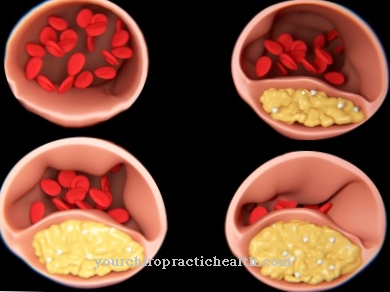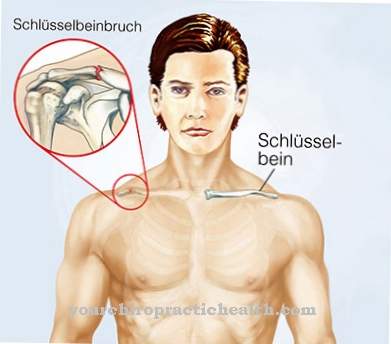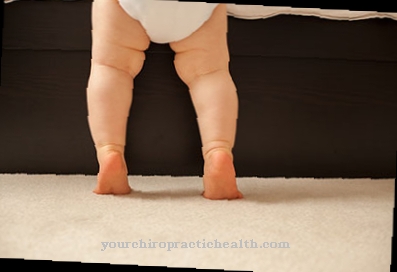The Pelizaeus-Merzbacher disease is a hereditary leukodystrophy with degeneration of the nerve substance. Those affected suffer from a mutation-related disorder of myelination, which mainly results in motor and intellectual deficits. The therapy of the disease has so far been limited to supportive measures of physical and psychotherapy.
What is Pelizaeus-Merzbacher Disease?

© Reing - stock.adobe.com
Leukodystrophies are genetically determined metabolic diseases in which the white matter of the nervous system progressively degenerates due to deficiency symptoms. Above all, the myelin that surrounds the nerves is broken down.
Myelin is an insulation in the human organism. As in a plastic cable, the bioelectrical action potential of the nerve excitation in myelinated nerve pathways is protected from loss in the environment. Without myelin, the function of a nerve is severely impaired. Loss of excitation occurs. The conduction of stimuli is difficult.
Patients with leukodystrophies therefore suffer from neurological deficits. Leukodystrophies are particularly noticeable in the area of motor skills. Pelizaeus-Merzbacher disease is a leukodystrophy, the first description of which goes back to the German neurologist F. C. Pelizaeus and the psychiatrist L. Merzbacher.
The disease is characterized by a disorder in the formation of the myelin sheath, which can manifest itself in a variety of different symptoms. All age groups can be affected. The prevalence is estimated at around one to nine cases out of 1,000,000 people. Different literature also refers to leukodystrophy as Brain sclerosis, diffuse familial leukodystrophy or Pelizaeus-Merzbacher cerebral sclerosis.
causes
Like all leukodystrophies, Pelizaeus-Merzbacher's disease is based on degeneration of the white nerve substance. In the case of the disease, this degeneration corresponds to a genetic disorder in the formation of myelin sheaths. The myelin formation disorder is due to a multiple mutation that has now been localized to that of the PLP1 gene.
This gene codes for the proteolipid protein 1 and is located in the Xq22 gene locus on the X chromosome. The type of mutation in the PLP gene can vary from case to case. The mutations can correspond to deletions, for example. Duplications of the gene have also been detected in patients with Pelizaeus-Merzbacher disease.
Due to the mutations, there is an incorrect production of proteolipid proteins. The defective proteins in turn result in defective myelin as they play an essential role in myelin synthesis. This creates functionless myelin sheaths, which lead to a loss of potential in the nerves. The disease is inherited in an X-linked recessive manner. For this reason, only the male sex usually becomes ill. Women are mostly silent carriers.
Symptoms, ailments & signs
The main symptom of Pelizaeus-Merzbacher's disease is a delay in mental and motor development. In addition to uncontrollable twitching of the eyes in the form of nystagmus, spastic and flaccid paralysis of the muscles as well as loss of tone with atactic stance and gait insecurity are among the main symptoms of the disease.
Symptoms usually only manifest themselves in toddlers or children. However, a manifestation in adulthood is also conceivable. Basically, the congenital form is usually the most difficult. In addition to the symptoms mentioned, dyspnoea or stridor often occur. Spastic tetraparesis is often part of the clinical picture.
In the classic form with manifestation in the first months of life, nystagmus and muscle hypotonia progressively turn into spasticity. In addition to the classic and congenital forms, there is a transitional form with a degree of impairment between the classic and the congenital variant. In principle, different degrees of severity are conceivable. The symptoms can be relatively diverse, so that the clinical picture of the patient often differs greatly.
Diagnosis & course of disease
The neurological examination and anamnesis provide the first indications of Pelizaeus-Merzbacher's disease. Since no biochemical markers are available for the disease, imaging plays the most important role in diagnostics. Magnetic resonance imaging of the brain shows disorders of myelination.
Since such disorders are not specific to Pelizaeus-Merzbacher's disease, a differential diagnostic distinction must be made from other demyelinating diseases. Magnetic resonance spectroscopy can help with this. The final confirmation of the suspected diagnosis usually takes the form of a molecular genetic analysis.
A detected mutation of the PLP1 gene is considered to confirm the diagnosis. In principle, prenatal diagnosis is possible. The patient's prognosis depends on the severity of the disease and the type of PLP mutation. Mild courses are just as conceivable as severe forms with a fatal course in childhood.
Complications
Because of the Pelizaeus-Merzbacher disease, those affected suffer from a number of different restrictions and complaints. In most cases, only very few of the symptoms can be completely cured, so that the person affected has to rely on the help of other people in his or her life. First and foremost, patients with this disease suffer from a significantly delayed development.
The motor development of the patient is also considerably restricted with this disease and there are still severe mental deficits. Likewise, those affected with Pelizaeus-Merzbacher disease suffer from an unsteady gait and various paralysis and other disorders of sensitivity. Occasionally there are signs of spasticity. In many cases, bullying or teasing can occur, especially among children, so that patients with Pelizaeus-Merzbacher disease also suffer from psychological complaints and depression.
A causal treatment of Pelizaeus-Merzbacher disease is not possible. Above all for the parents and for the relatives, the illness represents a strong psychological burden. Furthermore, some complaints can be limited with the help of therapies. However, there is no complete cure for this disease. It may also reduce the patient's life expectancy.
When should you go to the doctor?
Since Pelizaeus-Merzbacher disease leads to severe delays in child development, this disease must always be examined and treated by a doctor. This is the only way to avoid further complications. The earlier treatment for Pelizaeus-Merzbacher disease is initiated, the greater the chances of a full recovery.
See a doctor if the child is paralyzed or has an unsteady gait. The paralysis can affect different parts of the body. The motor or mental development of the child can also be significantly restricted and delayed. Should the parents notice these delays, a doctor should be consulted immediately. Some children also have spasticity due to Pelizaeus-Merzbacher disease.
As a rule, Pelizaeus-Merzbacher's disease is diagnosed by a pediatrician or a general practitioner. Further treatment, however, takes place at various specialists and depends on the exact severity of the symptoms. In the case of Pelizaeus-Merzbacher disease, psychological treatment is often useful, in which both parents and children can participate. The life expectancy of the person affected is usually not negatively reduced by Pelizaeus-Merzbacher disease.
Treatment & Therapy
Pelizaeus-Merzbacher disease is caused by genes. For this reason, there is currently no causal therapy for patients with the disease. At most, gene therapy could open up causal forms of therapy. Gene therapy approaches are currently a focus of medical research.
However, the approaches have not yet reached the clinical phase. Therefore, patients with Pelizaeus-Merzbacher disease are currently treated symptomatically and supportively. The individual therapy steps depend on the symptoms in each individual case. The focus of therapy is on supportive measures that are intended to delay the course and thus improve the quality of life of those affected.
These measures primarily include occupational and physiotherapy. Mental development can be supported through early intervention. In addition, relatives of those affected receive emotional support. Often parents, for example, are provided with a psychologist or psychotherapist. Contacts to the European Association against Leukodystrophies are established. Various university clinics also offer special consultation hours.
Outlook & forecast
Pelizaeus-Merzbacher disease has a chromosomal cause. It occurs in three different forms. This is determined by the age of onset and the severity of the disease or its severity. These parameters then also influence the prognosis. Male patients mainly suffer from this very rare disease.
The most serious symptoms are recorded in the congenital variant of the disease. If Pelizaeus-Merzbacher's disease does not break out until after birth, the symptoms gradually develop in different forms. The prognosis of the transitional form lies between the congenital and the classic Pelizaeus-Merzbacher disease. However, there are also milder courses of Pelizaeus-Merzbacher disease. Depending on the type of disease, the prognosis for this disease is different.
Without interdisciplinary treatment by neurologists, orthopedists, physiotherapists, gastroenterologists and pulmonologists, patients cannot be given sufficient help. The progressive course of the disease differs depending on the phenotype. Life expectancy does not necessarily have to be restricted in the presence of Pelizaeus-Merzbacher disease. At least with the milder courses it is relatively normal. Often the disease progresses more slowly in adolescence. How high the quality of life can be depends on the clinical picture.
The prognosis for severely affected people is different. These usually die before the age of twenty.Until then, those affected can only be relieved by symptomatic treatment.
prevention
So far, Pelizaeus-Merzbacher's disease can only be prevented through genetic counseling in the family planning phase. Depending on your own inheritance risk, you may decide against having your own child. In addition, prenatal diagnostics can take place if necessary.
Aftercare
Those affected with Pelizaeus-Merzbacher disease usually have only a few measures and options for aftercare available. In the case of this disease, rapid and, above all, early detection of the disease is very important in order to prevent further complications or complaints. Those affected should consult a doctor as soon as the first signs and symptoms of the disease appear in order to prevent further worsening of the symptoms or further complications.
As a rule, those affected with Pelizaeus-Merzbacher disease are dependent on measures of physiotherapy or physiotherapy, whereby self-healing cannot occur. Many of the exercises from these therapies can also be repeated at home. Since this is a genetic disease, those affected should carry out a genetic examination and advice if they want to have children so that Pelizaeus-Merzbacher's disease cannot recur in the children and their descendants.
Since the illness can also lead to depression and other psychological upsets, the help and support of one's own family and friends is often very important. Pelizaeus-Merzbacher disease does not usually reduce the life expectancy of the person affected.
You can do that yourself
Since the Pelizaeus-Merzbacher disease is genetic, there are no self-help measures that combat the cause of the disorder. In most cases, the disease manifests itself in childhood, so it is up to the parents and the families of the patients to take appropriate measures in good time.
Affected parents should first ensure that their child is treated by a doctor who has experience with this relatively rare disease. If the general practitioner cannot recommend an expert, the medical association will help. Many university hospitals have special consultation hours in which patients and their relatives can obtain comprehensive information about the disease and its progress. It is important for young parents to deal with what is in store for them and their sick child at an early stage. Well-informed parents find it easier to find a childcare place in good time and later a school that guarantees their child the best possible education.
In addition, caring for and living together with a disabled child is also a major challenge for relatives. Those affected should therefore not be afraid to seek help for themselves. Exchanging ideas with other people affected often helps. The European Association Against Leukodystrophies will help you get in touch.


.jpg)
























